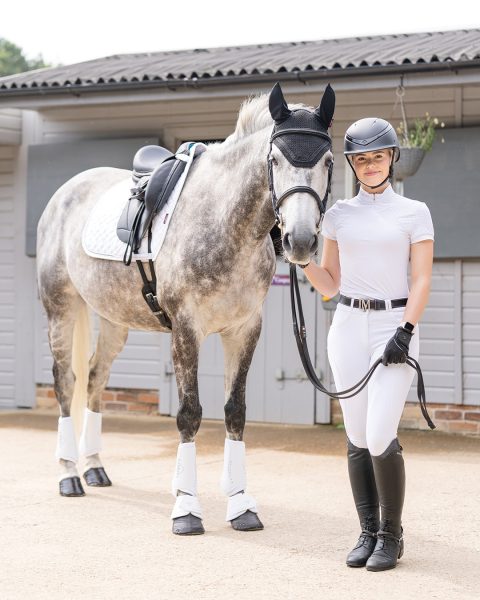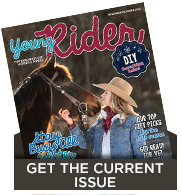When it comes to competing, a lot of people experience competition nerves—myself included! Today I’m going to share some tips that help me have more confidence at horse shows.

1. Training
Making sure that you feel completely ready to go into the show ring is a great way to feel more relaxed. Often with show jumping, I will enter a height that is a little bit smaller than I normally train at when I’m home. This is so it doesn’t feel as daunting on the big day—you already know that you’ve got this and can do it. That’s a great way to build confidence and build on success so that you have this foundation under your belt at a horse show.
Also, have lots of lessons with your trainer beforehand, ask lots of questions, and get advice on which area is best to focus on. For example, I know at shows, I always forget to look up. I sometimes focus too much of my attention on my horse, Joey, rather than where I’m going!
It’s human nature to do what we are good at, so you need to step back and look at yourself from the outside in order to see your weak areas and work on what needs the most attention.
2. Preparation
Always make sure you are organized and not late. This makes me feel a lot more settled at shows. The worst thing is having to rush, feeling stressed, and not having enough time in the warmup.
I like to arrive nice and early to give Joey a walk around the showgrounds so he gets used to his new surroundings. This is especially important if we’re somewhere new to him. I find this really helps both of us settle, relax and get into the competition mindset.
Shop Young Rider’s exclusive This Esme merch.
Before leaving for a show, I like to write a to-do list and everything that I need to pack, as there have been times when I’ve forgotten my girth or tendon boots for jumping. A checklist helps prevent this and takes away another worry or stress.
Having a routine at a show also really helps my nerves, too. Taking each task one at a time and knowing what the next step is helps prevent me from feeling overwhelmed. I think this calms Joey down, too. Sticking to the same familiar tacking up procedure is also a great idea, as horses are creatures of habit and love routine.
3. Warm Up
When you first get on your horse at a show you can start to tell how he’s feeling—he might be a bit different than usual. For example, Joey can be quite excited. He might be whinnying to all his new friends or feeling a bit speedier than usual.
I know that Joey has quite a busy brain, so what helps us is doing lots of transitions, circles and changes of rein so he never anticipates what I am going to ask next. This helps him keep his focus on me and not what’s going on around him.
Planning how long I want to spend in the warmup ring not only helps with time management beforehand, but also makes sure I’m exercising him for the optimum amount of time. Sometimes I need to warm up longer—especially after a long journey, Joey needs a bit more of a leg stretch to loosen up.
On the other hand, if you do too much in the warmup, this can tire your horse so he might not produce his best work in the ring. It’s important to be flexible and consider how your horse feels on the day. All these things come with experience—you won’t necessarily get it right first time, but that’s OK. A mistake is just an opportunity to learn and improve.
4. Having a Plan
Learning a dressage test or show jumping course can be tricky, but over time, I have learned some tips that help me. I have dyslexia, and often in a dressage test, I will accidentally flip the test in my head and go across the wrong diagonal or do a 20-meter circle at the wrong end of the arena.
When I go through my tests now, I always like to picture where the judges are sitting and use that, rather than the letters, so I don’t get muddled. If you are starting out, having someone call out the test can really help too. (This is allowed in dressage competitions and some schooling eventing shows.)
Another technique is to draw the test on a blank piece of paper. I feel this really helps me memorize where I go and when.
For show jumping, I like to walk the course more than once, and as I go past each fence, I memorize if I am turning left or right afterward. If you circle and cross your tracks, you will pick up four faults.
Having a plan and being prepared will help boost your confidence when you and your horse get into the show ring.
5. In the Ring
I find the buildup just before going into the ring to be the most nerve-wracking. But once I’m in there, focusing on my breathing, riding and the horse, it’s almost as if there’s no crowd or judges watching me at all, and all the nerves disappear quickly.
As hard as it sounds, not panicking and staying calm is the best thing you can do, as horses can really pick up on our emotions. You need to be brave for your horse, too.
It’s also important to remember that if it doesn’t go right, that’s OK. I’ve talked to multiple professional riders, and all of them have fallen off at a show at least once or forgotten their course—and I’m talking about Olympians here!
There will always be other classes or shows to enter if things don’t go perfectly, but at the end of the day, you should be proud of yourself for stepping out of your comfort zone and trying your best. I find the more shows I do, the more confident I feel, since I know what to expect. Nerves might not completely go away—and they show you really care—but understanding how to manage them and getting used to the feeling is what helps.
Lastly and certainly most importantly is to have fun, because that is why we do it!
This article about horse show confidence appeared in the July/August 2023 issue of Young Rider magazine. Click here to subscribe!


